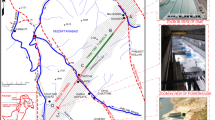Abstract
To transfer the excess water from Sabzkouh River in central Iran to cities beyond the river, a mechanized tunnel is being excavated. During construction and support installation in the first 100 m, tunnel roof collapse occurred and was followed by ground settlement, so that a cavity was developed in ground surface. The cavity had to be filled in a short time before rainy season, since the water flow through cavity could extend the collapse area in both tunnel roof and ground surface. In order to fill the cavity, some filling methods with different materials consist of in situ soil, lightweight concrete, and pumice aggregate lightweight concrete (PALWC) were suggested. To analyse the load distribution and minimize the costs, a three-dimensional analysis was carried out. Tunnel support system was simulated numerically to further evaluate loading state on support system under different material loadings. Mohr-Coulomb material model was used to allow material failure. The modelling procedure was based on actual construction procedure. Firstly, in situ model was modelled without any excavation and was run to establish pre-stresses and displacement, then slope was supported, the tunnel was excavated and support was installed and finally cavity was simulated. The numerical results show that filling the cavity with soil will result in over loading on the support system and leads to instability of the slope. Other two suggested filling materials have acceptable load on support system, but PALWC was selected as the best filling material having minimum loading and guarantees slope stability.


















Similar content being viewed by others
References
Attewell PB, Yeates J, Selby AR (Eds.) (1986) Soil movement induced by tunneling and their effects on pipelines and structures. Blackie Academic & Professional (Chapman & Hall)
Guglielmetti V, Grasso P, Mahtab A, Xu S (2007) Mechanized tunnelling in urban areas—design methodology and construction control. Taylor & Francis, London
Gunduz L (2008) The effects of pumice aggregate/cement ratios on the low-strength concrete properties. Constr Build Mater 22:721–728
IMN Consulting Engineers (2012) Stability analysis and portal support system design for soil part of Sabzkouh tunnel. 108 pages
ITA-AITES (2007) Report 2006 on settlements induced by tunneling in soft ground. Tunn Undergr Space Technol 22(2):119–149
Jiang QH, Yeung MR (2004) A model of point-to-face contact for three-dimensional discontinuous deformation analysis. Rock Mech Rock Eng 37(2):95–116
Jiang QH, Wei W, Yao C, Zhou CB (2011) Failure mode analysis of jointed rock masses around underground opening under excavation unloading. Mater Res Innov 15(S1):609–612
Jiang QH, Zhou CB, Li DQ, Yeung MR (2012) A softening block approach to simulate excavation in jointed rocks. Bull Eng Geol Environ 71(4):747–759
Jiang QH, Chen YF, Zhou CB, Yeung MR (2013) Kinetic energy dissipation and convergence criterion of Discontinuous Deformations Analysis (DDA) for geotechnical engineering. Rock Mech Rock Eng. doi:10.1007/s00603-012-0356-5
Juan KY (2011) Cracking mode and shear strength of lightweight concrete beams. PhD Thesis, National University of Singapore
Karakus M, Fowell RJ (2003) Effects of different tunnel face advance excavation on the settlement by FEM. Tunn Undergr Space Technol 18(5):513–523
Lee KM, Rowe RK (1991) An analysis of three-dimensional ground movements: the Thunder Bay tunnel. Can Geotec J 28(1):25–41
Lin DJ, Huang BS, Lin SH (2010) 3-D numerical investigations into the shear strength of the soil–root system of Makino bamboo and its effect on slope stability. Ecol Eng 992–1006
Mair RJ (2008) Tunnelling and geotechnics: new horizons. Geotechnique 58(9):695–736
Nam S, Gutierrez M, Diplas P, Petrie J (2011) Determination of the shear strength of unsaturated soils using the multistage direct shear test. Eng Geol 122:272–280
O’Reilly MP, New BM (1982) Settlements above tunnels in the United Kingdom: their magnitude and prediction. In: Tunnelling ’82: Third International Symposium, Brighton, East Sussex, United Kingdom, pp 173–181
Peck RB (1969) Deep excavations and tunnelling in soft ground. In: Proceedings of 7th International Conference on Soil Mechanics and Foundation Engineering, Mexico City, Mexico, State-of-the-art Volume, pp 225–289
Schnellmann R, Rahardjo H, Schneider HR (2013) Unsaturated shear strength of a silty sand. Eng Geol. doi:10.1016/j.enggeo.2013.05.011
Shin JH, Potts DM (2003) Time-based two dimensional modelling of NATM tunneling. Can Geotech J 39(3):710–724
Shin JH, Addenbrooke TI, Potts DM (2002) A numerical study of the effect of groundwater movement on long-term tunnel behavior. Geotechnique 52(6):391–403
Singh B, Goel RK (2006) Tunnelling in weak rocks. Elsevier Geo-engineering book series, vol 5. Elsevier Ltd, Oxford
Wong RCK, Kaiser PK (1991) Performance assessment of tunnels in cohensionless soils. J Geotech Eng 117(2):1880–1901
Wongsaroj J, Soga K, Mair RJ (2007) Modelling of long-term ground response to tunnelling under St James’s Park. London Geotechnique 57(1):75–90
Zhang K, Cao P, Bao R (2013) Rigorous back analysis of shear strength parameters of landslide slip. Trans Nonferrous Met Soc China 23:1459–1464
Author information
Authors and Affiliations
Corresponding author
Rights and permissions
About this article
Cite this article
Aliabadian, Z., Sharafisafa, M., Nazemi, M. et al. Numerical analyses of tunnel collapse and slope stability assessment under different filling material loadings: a case study. Arab J Geosci 8, 1229–1242 (2015). https://doi.org/10.1007/s12517-014-1286-1
Received:
Accepted:
Published:
Issue Date:
DOI: https://doi.org/10.1007/s12517-014-1286-1




